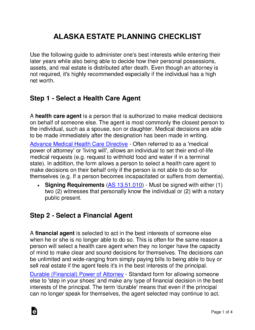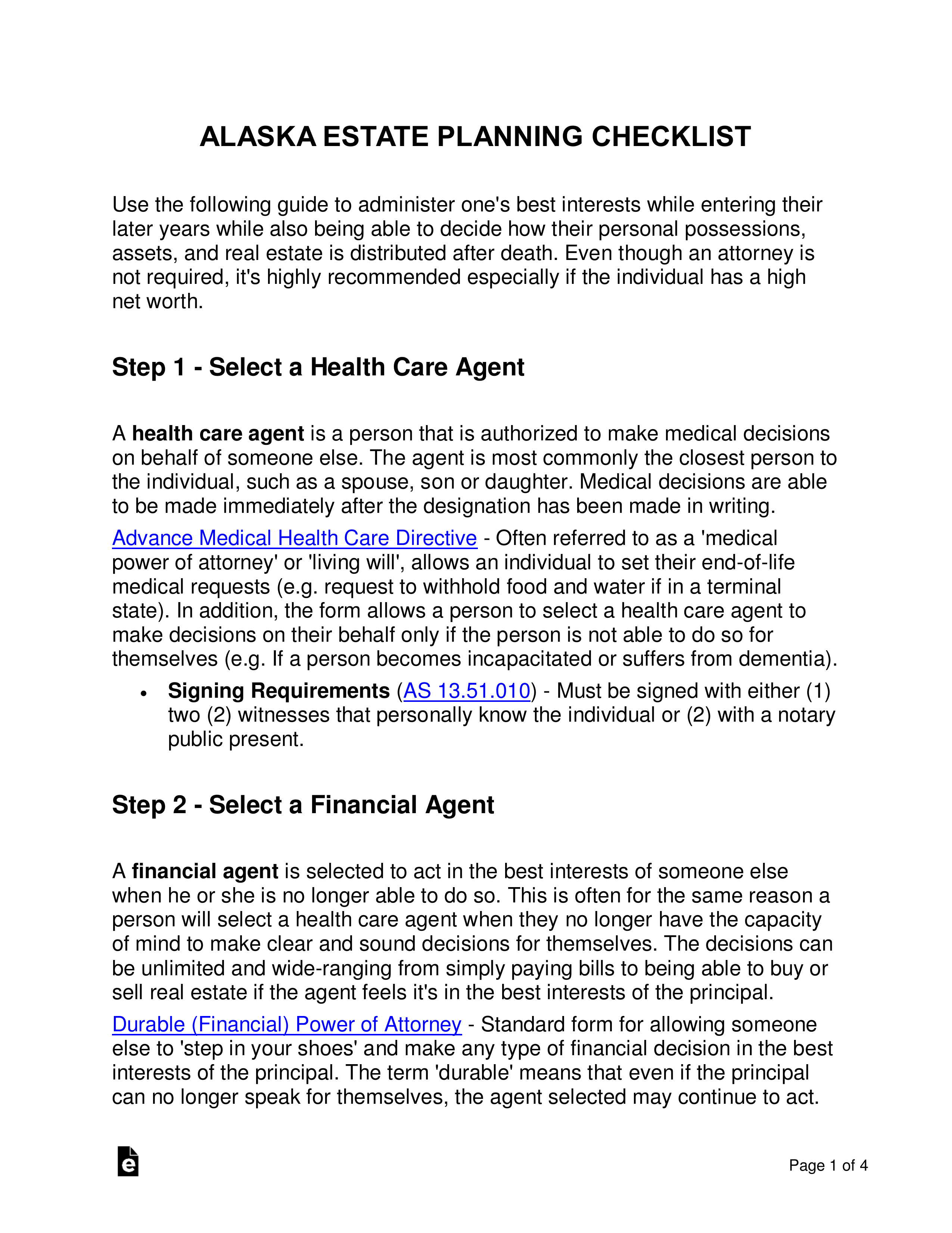Updated April 16, 2024
An Alaska estate planning checklist provides a list of documents that a person uses to set their medical and financial requests for later in life, as well as assign the beneficiaries who will inherit their assets and property after their death. For medical requests, the Advance Health Care Directive should be used and for financial the Durable Power of Attorney must be completed. When transferring one’s assets and property, the Last Will and Testament or Revocable Living Trust should be used depending on the financial status of the individual.
How to Create an Estate Plan in Alaska (6 steps)
- Select a Health Care Agent
- Select a Financial Agent
- Make a List of All Estate Items
- Talk to the Beneficiaries
- Decide How to Transfer the Estate
- Keep the Documents Safe
Use the following guide to administer one’s best interests while entering their later years while also being able to decide how their personal possessions, assets, and real estate is distributed after death. Even though an attorney is not required, it’s highly recommended especially if the individual has a high net worth.
1. Select a Health Care Agent
A health care agent is a person that is authorized to make medical decisions on behalf of someone else. The agent is most commonly the closest person to the individual, such as a spouse, son or daughter. Medical decisions are able to be made immediately after the designation has been made in writing.
Advance Medical Health Care Directive – Often referred to as a ‘medical power of attorney’ or ‘living will,’ allows an individual to set their end-of-life medical requests (e.g. request to withhold food and water if in a terminal state). In addition, the form allows a person to select a health care agent to make decisions on their behalf only if the person is not able to do so for themselves (e.g. If a person becomes incapacitated or suffers from dementia).
- Signing Requirements – Must be signed with either (1) two (2) witnesses that personally know the individual or (2) with a notary public present.[1]
2. Select a Financial Agent
A financial agent is selected to act in the best interests of someone else when he or she is no longer able to do so. This is often for the same reason a person will select a health care agent when they no longer have the capacity of mind to make clear and sound decisions for themselves. The decisions can be unlimited and wide-ranging from simply paying bills to being able to buy or sell real estate if the agent feels it’s in the best interests of the principal.
Durable (Financial) Power of Attorney – Standard form for allowing someone else to ‘step in your shoes’ and make any type of financial decision in the best interests of the principal. The term ‘durable’ means that even if the principal can no longer speak for themselves, the agent selected may continue to act.
- Signing Requirements – Must be signed by the principal and a notary public.[2]
Financial Powers Allowed:
- Real estate transaction;
- Transactions involving tangible personal property, chattels, and goods;
- Bonds, shares, and commodities transactions;
- Banking transactions;
- Business operating transactions;
- Insurance transactions;
- Estate transactions;
- Gift transactions;
- Claims and litigation;
- Personal relationships and affairs;
- Benefits from government programs and military service;
- Records, reports, and statements;
- Delegation;
- Voter registration and absentee ballot requests; and
- and other requests as allowed within the State by the Principal.
3. Make a List of All Estate Items
After the medical and financial terms are complete while the individual is living, he or she can now focus on where such assets should go after they have passed on. Before this document can be drafted, all ownership interest in certain properties must be outlined. It’s recommended to place all certificates proving ownership in a safe place such as a safety deposit box or with a personal attorney.
Current Assets List – Use as a guide to help write down all personal property, assets, and real estate holdings.
4. Talk to the Beneficiaries
5. Decide How to Transfer the Estate
If a person wants to convey their estate after their death there are two (2) options:
Last Will and Testament (‘Will’) – Allows an individual to write a document outlining all their property and specify exactly who it should go to after their death. The Will also has the option of specifically excluding people from receiving any items as well as creating a trust for minors so that they can only get ahold of their portion once they get to a certain age. Does Not avoid the probate process.
- Signing Requirements – Required to be signed with at least two (2) witnesses present.[3]
Revocable Living Trust – Allows a person to create an entity while living and make themselves the grantor (‘creator’) and trustee (‘beneficiary’). The successor trustees would effectively be the beneficiaries which means that they would collect the assets and property after the individual’s death. An added benefit to a Living Trust is that the creator has the option to amend or terminate the trust at their whim anytime. Does avoid the probate process.
-
- Signing Requirements – Must be registered in Local Court of the Trustee. The Living Trust must be accompanied by Form P-200.[4]
6. Keep the Documents Safe
Alaska Estate Planning Laws
- Advance Health Care Directive – Title 13, Chapter 52 (Health Care Decisions Act)
- Durable Power of Attorney – Title 13, Chapter 26, Article 5 (Powers of Attorney)
- Last Will and Testament – Title 13, Chapter 12 (Intestacy, Wills, and Donative Transfers)
- Living Trust (Revocable) – Title 13, Chapter 36 (Trust Administration)


